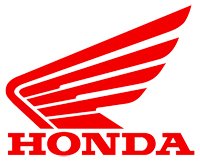
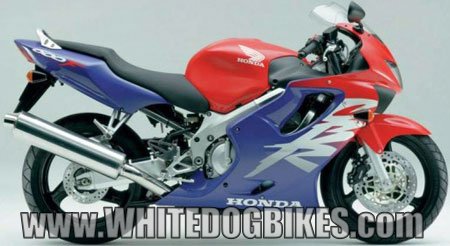
Honda CBR600 FX in red/blue
Honda CBR600 FX/FY Specs…..
The Honda CBR600 FX and FY models (also know as the CBR600 F4 outside the UK) was a fully faired, 599cc sports motorcycle produced by Honda and available for sale in the UK between 1998 and 2000.
The CBR600 FX and FY models were the last of the CBR600 range to use a carburettor for fuelling (the next model, the CBR600 F1 used a fuel injection system). The model was completely redesigned and uprated for it’s November 1998 release including new bodywork which included air intakes on either side of the front fairing (by the headlight) and a higher revving engine which was made possible by using larger valves, shorter stroke and a bigger cylinder bore.
The model had numerous other changes and upgrades including a new frame which was a twin spar aluminium frame (called a ‘diamond’ frame by Honda) which helped to make the bike 16kg’s lighter then the previous model and the engine crankcase was part of the swing arm mounting. It also benefitted from uprated rear mono shock, 43mm front forks, calipers, headlight and new spark plug caps with ignition coils built into them.
Need parts for your CBR600? Honda CBR600 spares on Amazon…
A little bit about the Honda CBR 600 F4…..
Basic model info… |
|
|---|---|
| Manufacturer: | Honda |
| Model: | CBR600 FX and FY (also know as F4) |
| CC: | 599cc |
| Engine type: | Inline 4 cylinder (4 stroke) |
| Years in production: | 1998 to 2000 |
| Years and registration marks (approx): |
More detailed release date and model info can in the ‘Models and years’ section below |
| Style of bike: | Sports bike |
| Insurance: | Group 14 (of 17) |
| Preceding model: | CBR600 FW (aka F3) |
| Succeeded by: | CBR600 F1 (fuel injected – aka F4i) |
Servicing your bike? You’ll need a CBR600 F4 workshop manual…
Models and years (in the UK) |
|
|---|---|
| CBR600 FX (Nov 1998 to Aug 1999)….. | |
| Frame number started: | PC31A-VM1——- |
| Description: | All new, redesigned CBR600 model. Has new twin spar, aluminium alloy ‘diamond’ frame, uprated suspension, all new engine, 4-2-1 exhaust system, ignition key immobiliser system (Honda H.I.S.S system), new fairings with air intake ducts on the sides of the front fairing. |
| Available colours: | Red/blue, black/silver and yellow/black/blue |
| Price (new): | £6995 for an ‘S’ reg, £6099 for a ‘T’ reg and £6099 for a ‘V’ reg |
| CBR600 FY (Sept 1999 to Nov 2000)….. | |
| Frame number started: | JH2PC35A-YM100001– |
| Description: | Same as above model with new colours. |
| Available colours: | Blue/red, black and black/yellow |
| Price (new): | £6295 for a ‘V’ reg, £6295 for a ‘W’ reg and £6550 for an ‘X’ reg |
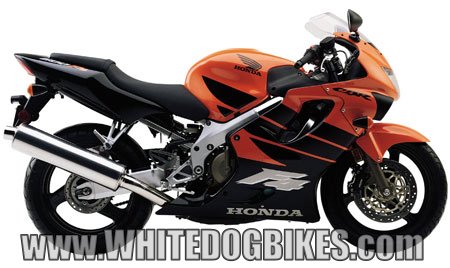
US CBR600 F4 (colours were different for US models)
Engine and gearbox specs….. |
|
|---|---|
| Displacement: | 599 cc |
| Engine type: | Inline 4 cylinder |
| Bore×Stroke: | 67×42.5mm |
| No. of cylinders: | 4 (inclined 31 degrees from vertical) |
| Engine revs to (redline): | 13,500 rpm |
|
|
| Cam shaft configuration: | DOHC (double overhead cam – chain driven) |
| Compression ratio: | 12.0:1 |
| Cylinder compression pressure: | 12.5 bar |
| Valves: | 16 valve (4 per cylinder) |
| Engine dry weight (without oil and coolant): | 59kg |
| Spark plug: | NGK CR9EH-9 (x4) |
| Spark plug gap: | 0.8 to 0.9mm |
| Firing order: | 1 – 2 – 4 – 3 |
| Engine oil: | 10w40 API SG or higher |
|
|
| Engine oil capacity (oil only): | 3 litres |
| Engine oil capacity (oil and filter change): | 3.3 litres |
| Engine oil capacity (after disassembly / rebuild): | 3.7 litres |
| Engine oil drain bolt torque: | 29nm |
| Engine oil drain bolt location: | Bottom/right side of the engine behind the fairing |
| Oil filter type: | Canister type |
| Oil filter: | Hiflo HF303 / Filtrex OIF006 |
| Oil filter torque: | 10nm |
| Oil pressure: | 71 psi (@ 6000 rpm) |
| Cooling system: | Liquid cooled |
| Cooling system capacity: | 3.1 litres |
| Thermostat begins to open: | 73 to 77 degrees c |
| Thermostat fully open: | 90 degrees c |
| Clutch: | Wet (oil immersed) multiplate clutch |
| Clutch hub tightening torque (center locking nut): | 127nm |
| Clutch operation: | Cable |
| Clutch lever free play: | 10 to 20mm |
| Gearbox: | 6 Speed manual (1st gear down, 2nd to 6th gears up, neutral between 1st and 2nd gears) |
| BHP: | 110 bhp (@ 12,500 RPM) |
| Rear wheel HP: | 94.1 HP at the rear wheel |
| Top speed (claimed): | 158mph |
| 0 to 62mph time (claimed) : | 3.2 seconds |
| KW output: | 81 KW (@ 12,500 RPM) |
| Torque: | 65nm (@ 10,500 RPM) |
| Piston ring to cylinder bore clearance: | New: 0.015mm / Max 0.050mm |
| Valve clearance (inlet): | 0.20mm (+/- 0.03mm) (when cold) |
| Valve clearance (exhaust): | 0.28 (+/- 0.03mm) (when cold) |
| Idle speed: | 1,200rpm (+/- 100) |
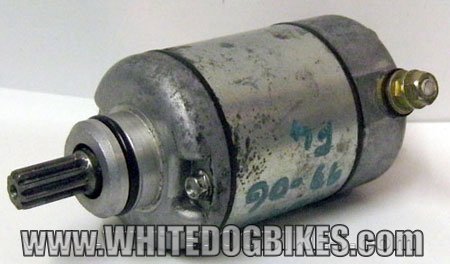
CBR600 FX/FY starter motor
Final drive stuff….. |
|
|---|---|
| Final drive: | Chain |
| Front sprocket: | 16 teeth |
| Front sprocket bolt torque: | 54nm |
| Rear sprocket: | 44 teeth |
|
|
| Rear sprocket bolts torque: | 88nm |
| Chain pitch/length: | 525 / 110 |
| Chain free play: | 25 to 35mm |
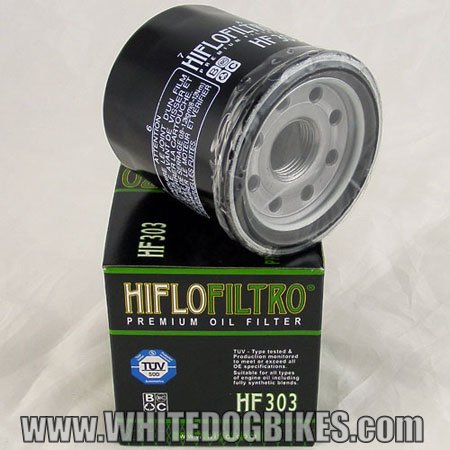
Honda CBR600 canister type oil filter (Hiflo HF303)
Carb, fuel and oil stuff….. |
|
|---|---|
| Fuel system: | Carburetor |
| MPG: | 35 to 44 miles per gallon (very approx) |
|
|
| Fuel tank range: | approx 120 miles |
|
|
| Fuel tank capacity: | 18 litres |
| Fuel type: | Unleaded petrol (91 octane grade – aka standard petrol from your local garage) |
| Carb type: | CV (constant velocity) |
| Carb make: | Keihin (4x) |
| Carb type: | VP64A |
| Pilot screw opening: | 3 turns |
| Carb float level: | 13.7mm (+/- 0.5mm) |
| Fuel pump flow: | 700cm3 per minuite |
| Throttle grip free play: | 2 to 6mm |
| Engine oil: | 10w40 API SG or higher |
| Engine oil capacity (oil only): | 3 litres |
| Engine oil capacity (oil and filter change): | 3.3 litres |
| Engine oil capacity (after disassembly / rebuild): | 3.7 litres |
| Engine oil drain bolt torque: | 29nm |
| Engine oil drain bolt location: | Bottom/right side of the engine behind the fairing |
| Oil filter: | Hiflo HF303 / Filtrex OIF006 |
| Oil filter type: | Canister type |
| Oil filter torque: | 10nm |
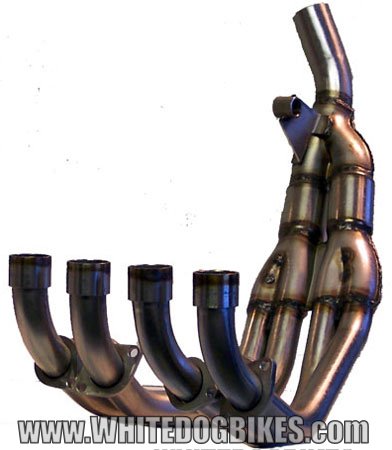
CBR600 FX/FY exhaust downpipes – These are aftermarket 4-2-1 headers (hence the lack of balance pipes between the down pipes)
Electric stuff….. |
|
|---|---|
| Ignition type: | Electronic CDI |
| Starter: | Electric start |
| Electrical system voltage: | 12 volts |
| Battery voltage (fully charged): | 13 to 13.2 volts |
| Battery amps per hour: | 8 a/h |
| Battery will need charging if below: | 12.3 volts |
| Battery charging current (normal): | 0.9 amps on a 5 to 10 hour charge |
| Battery charging current (quick – NOT recommended!): | 4.0 amps on a 1 hour charge |
| Regulated voltage: | 14 to 15 volts (@ 5000 rpm) |
| Alternator output (max): | 28.5 a/h (@ 5000 rpm) |
| Magneto / flywheel tightening torque: | 103nm |
| Spark plug: | NGK CR9EH-9 (x4) |
|
|
| Spark plug gap: | 0.8 to 0.9mm |
| Spark plug tightening torque: | 12nm |
| Spark plug ignition: | 4 x combined spark plug cap and coil |
|
|
| Spark plug coil peak voltage: | 100 volts (minimum) |
| Battery: | CTX9-BS / YTX9-BS / CBTX9-BS |
|
|
| Immobiliser: | Honda HISS system (Honda Ignition Security System) |
|
|
| Cooling fan switch starts to close (turns the fan on): | Between 98 and 102 degrees C |
| Cooling fan switch open (turns the fan off): | Between 93 and 97 degrees C |
| Bulb, light and fuse info… | |
| Headlight high/low beam: | 12 volt / 60/55 watt (1x) |
| Rear light / brake light: | 12 volt / 21/55 watt (2x) |
| Indicator light: | 12 volt / 21 watt (4x) |
| Instrument lights (on the clocks): | 12 volt / 1.1 watt (3x) |
| Indicator lights (on the clocks): | 12 volt / 1.1 watt (2x) |
| High beam indicator (on the clocks): | 12 volt / 1.1 watt (1x) |
| Neutral indicator (on the clocks): | 12 volt / 1.1 watt (1x) |
| Oil pressure indicator (on the clocks): | 12 volt / 1.1 watt (1x) |
| Main fuse (located off the + battery terminal): | 30 amp |
| Sub fuses: | 10 amp (x4) |
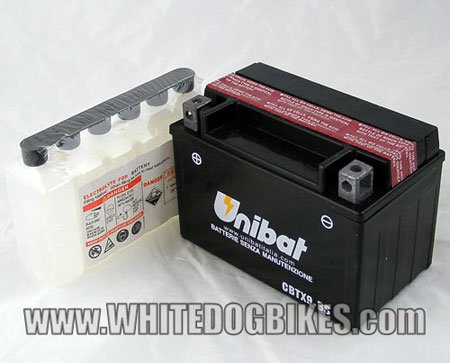
1998 to 2000 Honda CBR600 battery (YTX9-BS)
Shocks, brakes and wheel specs….. |
|
|---|---|
| Front wheel type: | 3 spoke wheel |
| Front tyre size: | 120/70-17 |
| Front tyre pressure: | 36psi (2.5 bar) |
| Front wheel spindle torque: | 59nm |
| Front wheel spindle clamp bolt torque: | 22nm |
| Rear wheel type: | 3 spoke wheel |
| Rear tyre size: | 180/55-17 |
| Rear tyre pressure: | 42psi (2.9 bar) |
| Rear wheel spindle torque: | 93nm |
| Front brake: | Twin hydraulic disc brake with 4 piston calipers |
| Front brake caliper bolt tightening torque: | 30nm |
| Front brake disc: | 2x 296mm discs. Part no: EBC MD1014X (2x, same part no for left and right disc) |
| Front brake disc bolt torque: | 20nm |
| Front brake pad: | EBC FA296 (2 x, same pads for both left and right sides) |
| Rear brake: | Single hydraulic disc brake |
| Rear brake disc: | Single 220mm disc. Part no: EBC MD1004 |
| Rear brake disc bolt torque: | 42nm |
| Rear brake caliper bolt torque: | 30nm |
| Rear brake pad: | EBC FA174 |
| Brake fluid (front and rear): | DOT 4 brake fluid |
| Front suspension: | Telescopic forks |
| Front fork stanchion diameter: | 43mm |
| Front fork pinch bolt torque (top): | 23nm |
| Front fork pinch bolt torque (bottom): | 39nm |
| Front fork cap torque: | 23nm |
| Steering stem nut torque: | 103nm |
| Recommended fork oil: | 10w (medium weight) fork oil |
| Fork oil volume: | 475 cm3 (per fork) |
| Rear Suspension: | Single rear shock (monoshock) with remote reservoir |
| Rear shock mounting nut torque: | 44nm |
| Shock arm to swing arm nut torque: | 44nm |
| Shock link to bracket nut torque: | 44nm |
Weights, measures ‘n stuff….. |
|
|---|---|
| Overall length: | 2060mm |
| Overall width: | 685mm |
| Overall height: | 1130mm |
| Wheelbase: | 1395mm |
| Seat height: | 810mm |
| Footpeg height: | 360mm |
| Ground clearance: | 135mm |
| Dry weight (no oils, fluids etc): | 170kg |
| Loaded weight (with oils, fluids etc): | 198kg |
| Max weight carrying capacity (rider, pillion and luggage): | 189kg |
Useful torque settings….. |
|
|---|---|
| Cam cover: | 10nm |
| Camshaft sprocket: | 22nm |
| Camshaft holder bolt: | 12nm |
| Timing hole cap: | 18nm |
| Magneto / flywheel: | 103nm |
| Cylinder head bolt: | 47nm |
| Cylinder head cover bolt: | 10nm |
| Clutch hub (center locking nut): | 127nm |
| Spark plugs: | 12nm |
| Front brake disc bolt torque: | 20nm |
| Rear brake disc bolt torque: | 42nm |
| Front wheel spindle: | 59nm |
| Front wheel spindle clamp bolt: | 22nm |
| Rear wheel spindle: | 93nm |
| Front brake caliper bolt: | 30nm |
| Rear brake caliper bolt: | 30nm |
| Front fork pinch bolt (top): | 23nm |
| Front fork pinch bolt (bottom): | 39nm |
| Front fork cap: | 23nm |
| Steering stem nut torque: | 103nm |
| Rear shock mounting nut: | 44nm |
| Shock arm to swing arm nut: | 44nm |
| Shock link to bracket nut: | 44nm |
| Engine oil drain bolt: | 29nm |
| Oil filter: | 10nm |
| Oil pressure switch: | 12nm |
| Front sprocket bolt: | 54nm |
| Rear sprocket bolts: | 88nm |
| Side stand pivot bolt: | 10nm |
| Rider footpeg hanger bolt: | 26nm |
| Pillion footpeg hanger bolt: | 26nm |
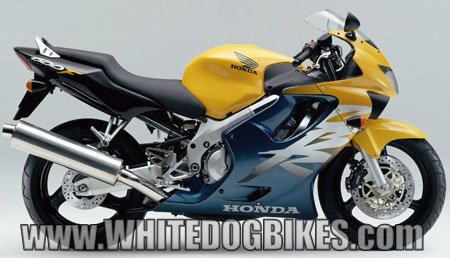
1999 CBR600 FX in yellow, black and blue
Service stuff….. |
|
|---|---|
| Servicing your bike? You’ll need a CBR600 FX/FY workshop manual… | |
| Engine oil | |
| Engine oil change frequency: | Every 12,000km (approx 7,456 miles) or 12 months |
| Engine oil: | 10w40 API SG or higher |
|
|
| Engine oil capacity (oil only): | 3 litres |
| Engine oil capacity (oil and filter change): | 3.3 litres |
| Engine oil capacity (after disassembly / rebuild): | 3.7 litres |
| Engine oil drain bolt torque: | 29nm |
| Engine oil drain bolt location: | Bottom/right side of the engine behind the fairing |
| Oil filter: | Hiflo HF303 / Filtrex OIF006 |
| Oil filter torque: | 10nm |
| Chain drive | |
| Final drive chain frequency: | Now repeat after me… ‘I MUST LUBE MY CHAIN LITTLE AND OFTEN!!’ |
| Chain and sprocket size: | 110/525 Chain, 16 tooth front and 44 tooth rear sprocket |
| Front sprocket bolt torque: | 54nm |
| Rear sprocket bolts torque: | 88nm |
| Hydraulic brake system (front and rear) | |
| Brake fluid check frequency: | Check every 12 months or 6,000km (approx 3,728 miles) |
| Brake fluid change frequency: | Change every 24 months or 18,000km (approx 11,185 miles) |
| Brake fluid: | DOT 4 brake fluid |
| Fork oil | |
| Front fork oil check frequency: | Check every 12,000km (approx 7,456 miles) or 12 months |
| Recommended fork oil: | 10w (medium weight) fork oil |
| Fork oil volume: | 475 cm3 (per fork) |
| Cooling system | |
| Coolant check frequency: | Check every 12,000km (approx 7,456 miles) or 12 months |
| Change every: | 36,000 km (approx 22,369 miles) or 24 months |
| Cooling system: | Liquid cooled |
| Cooling system capacity: | 3.1 litres |
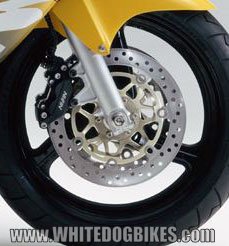
Honda CBR600 F4 front brake caliper and disc
Frame number location…..
The frame number is usually stamped onto the right side of the headstock (the front part of the frame just below the handle bars).
Useless stuff…..
Middleweight sports bike from Honda that was heavily redesigned for the November 1998 release to compete with Kawasaki’s ZX6R Ninja and the much newer and radical Yamaha YZF-R6. Although it was no real competition to the Yam R6, the CBR600 was a good, solid all round sports bike that was both good for a quick weekend blast or a long few weeks touring round Europe.
The new CBR600 was 16kg lighter then the previous model which was achieved, among other things, by a new designed frame. European models were also fitted with the Honda H.I.S.S system (Honda Ignition Security System) which was an factory fitted immobiliser system.
The model was dedicated by Honda to Dirk Vandenberg and Josef Boyd who were Honda R and D senior product developers for this model and were killed during the final testing.
Performance wise, even by modern standards it’s a quick bike. Although it didn’t quite have the racing image of the Yamaha R6 or the ‘bad boy’ image of the ZX6R Ninja or the GSXR600 it still easily kept up and beat most of the competition (I had one in the late 1990’s the dated ZX6R’s and Gixxer 600’s couldn’t keep up with it!). They were also used in stock 600cc racing series.
The main things that set the CBR600 apart were Honda reliability (I covered 55,000 miles in one in 2 years, missed most of the services and it only broke down once, which was totally my fault as I went through a deep puddle and got water in the airbox!! 🙁 ), and, unlike other bikes that had you clutching your backside after 25 miles it was comfortable, you could ride 300 miles and/or ride all day on one.
The only thing that really let it down was the stupidly small tank range (around 120 miles…. 110 if ridden hard!) which meant if you were doing alot of miles you couldn’t stray too far from a petrol station!
The bike had a claimed 110bhp, which worked out to about 94hp at the rear wheel, 0 to 62 time of 3.2 seconds and a top speed of around 158mph (it will actually do this….. so I’ve heard!).
Performance parts were readily available as there were loads of these models sold and, you could get more specialist parts (rear sets, racing cam’s etc) due to the bike being used for racing.
I had a few subtle / low key performance mods on mine as I wanted to keep the bike able to be ridden all day so I used a 2 tooth bigger sprocket on the rear wheel, Harris performance race can (one of the best if you can still find one!), a stage 1 Dynojet kit and a K and N air filter. This got rid of the flat spot, increased the acceleration (although I did lose a bit of top end speed) and sounded amazing with the end can 🙂
Braking wise the bike was a fairly good stopper as standard, the 4 piston front calipers had the stopping power to keet you out of trouble. Improvements could be made by fitting braided hoses and HH pads to the front.
Buying advice…..
Firstly, if your thinking of buying one always HPI check it (there’s still loads about so no point risking getting stuck with a lemon!).
Good, solid bike from Honda. There were 1000’s sold so there are still plenty about. Mileage isn’t really anything to worry about as long as it’s had oil and filter changes and the cam chain has been changed at the service intervals (if the cam chain snaps it’ll destroy the engine!).
There are quite a few ex racers around. Due to a harder lifestyle on the track they can have lots of niggling little faults and because there are alot of these bikes about, it might be better getting a non raced example if you have the money (racing bikes can often be spotted by drilled sump plugs and other bits).
Also, people have reported the Honda HISS immobiliser systems failing. This could prove expensive as the system is connected to the ignition and ECU. Apparently, US models didn’t have this system so people did buy key, ignition switch and ECU sets used from the USA (but I don’t know if this is true or not?).
They were built to take a reasonable knock as well, so lightly damaged bikes aren’t a problem (although fairings will be difficult to source now as the bike is 17 odd years old). Also, if you buy one with the original rear shock and brake hoses, these will probably be due for replacement.
The standard exhaust systems were mild steel and did rot (nothing unusual, just the effects of time and weather!). But, replacement exhaust headers, link pipes and cans of dubious stainless steel quality are readily available for not much ££’s (exhaust downpipes can be bought for under £200).
Sources / Thanks to:
CBR600F article on Wikipedia
EBC brakes
Silkolene for the service info
If you’ve got any questions or useful comments or suggestions please feel free to leave them below 🙂
Disclaimer: The information on this page is correct to the best of our knowledge. But the info should NOT be taken as 100% accurate as we can, occasionally make mistakes!

Leave a Reply